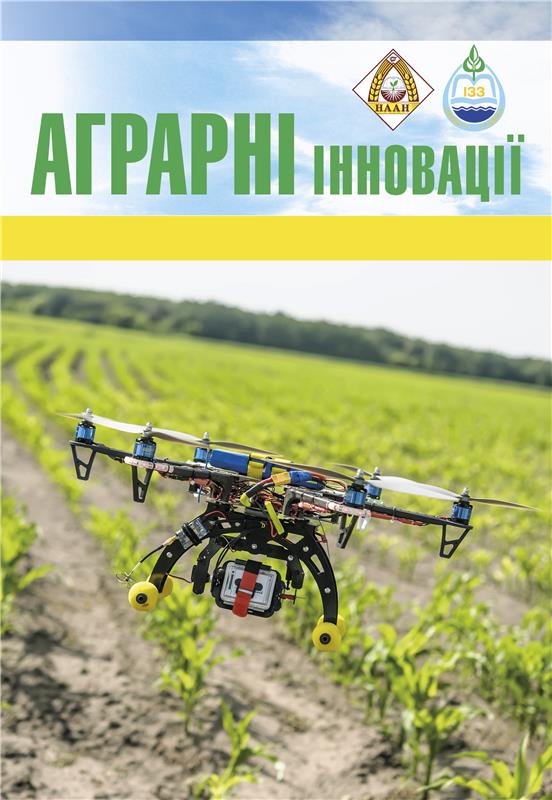PECULIARITIES OF GROWTH AND DEVELOPMENT OF FODDER BEET PLANTS DEPENDING ON SOWING DATES AND SEED EMBEDDING DEPTH IN THE CONDITIONS OF THE WESTERN FOREST-STEPPE
Abstract
Goal – to investigate the influence of sowing dates and seed embedding depth on the growth and development of fodder beet plants in the conditions of the west- ern Forest-Steppe of Ukraine. Methods. The research was conducted during 2020–2024 on the experimental field of the Educational and Production Center "Podillia" of the Higher Education Institution "Podillia State University" on typical low-humus, medium-loamy black soil. The repetition in the experiment is fourfold. The placement of variants is systematic. The technology of growing fodder beet in the experiment is generally accepted, except for the factors under study. Results. According to the results of the research, it was found that the duration of the “sowing-emergence” period depends on the temperature regime and the level of soil moisture at the depth of seed embedding, and decreases with each subsequent sowing period.During the first sowing period (the first decade of April, upon reaching physical ripeness of the soil and its temperature regime of warming up to 5–6°C), the duration of the “sowing-emergence” period was 22–27 days for the Sonet variety, 20–24 days for the second, 19–22 days for the third, and 16–20 days for the fourth. A similar trend was observed in other varieties submitted for study. It is worth noting that early sowing dates, unlike late ones, lead to an increase in the duration of the growing season. Thus, when sowing in the fourth term (the first decade of May), the duration of the period “seedlings – formation of the second pair ofleaves” compared to the first term of sowing was shorter in the Sonet variety by 5–7 days, the Olzhych variety by 4–5 days, and the Starmon variety by 5–6 days. In general, the period “seedlings – closing of leaves in the inter-rows” when sowing in the fourth term was shorter by 8–10 days in all studied varieties compared to the first term. It was established that with an increase in the depth of wrapping of fodder beet seeds, the period from sowing to the appearance of seedlings is extended. A similar dependence was observed in subsequent phases of development, in particular from seedlings to closing of leaves in the inter-rows.Conclusions.The highest field germination of fodder beet seeds was in all studied varieties in the first and second sowing dates – 85.3% and 84.6%. In terms of varieties, the highest field germination was in the Starmon variety, regardless of the sowing dates. Thus, when sowing in the first decade of April, the field germination of seeds was 96.5% with a planting depth of 4–5 cm, when sowing in the second decade of April – 95.2%, in the third decade – 92.6%, and 88.7% when sowing in the first decade of May.The optimal time for sowing fodder beet should be considered the second and third terms, it was during this period that optimal conditions for germination were created for plants, there was a sufficient amount of moisture in the soil, and the temperature of the upper layer was 7–10°C. It was established that the duration of the growing season for the first term of sowing for all studied varieties was 153–158 days, and the shortest for late term sowing (first decade of May) was 137–143 days.
References
2. Роїк М. В. Буряки. Київ : ХХІ вік. РІА "Труд-Київ", 2001. 320 с.
3. Безвіконний П. В. Вплив строків сівби на нагромадження маси коренеплодів буряка столового. Вісник Житомирського національного агроекологічного університету. 2015. № 1(1). С. 151–156.
4. Умрихін Н., Іщенко В., Козелець Г. Строки висівання озимої пшениці залежно від попередників. Пропозиція – Головний журнал з питань агробізнесу. URL: https://propozitsiya.com/ua/stroky-vysivannya- ozymoyi-pshenyci-zalezhno-vid-poperednykiv (дата звернення: 21.02.2025).
5. Особливості технології вирощування буряків кормових як сировини для виробництва біогазу. URL: http:// naas.gov.ua/news/?ELEMENT_ID=6371 (дата звернення: 22.02.2025).
6. Бурко Л. М. Ріст, розвиток і врожай буряків кормових залежно від елементів технології вирощування. Збірник наукових праць Інституту біоенергетичних культур і цукрових буряків НААН. 2012. Вип. 14. С. 257–260.
7. Безвіконний П. В., М’ялковський Р. О., Тарасюк В. А. Вплив строків сівби насіння буряка столового на зберігання коренеплодів. Збірник наукових праць БНАУ. 2020. Вип. 1 (157). Серія «Агробіологія». С. 7–12.
8. Меланія Несмачна. Аграріям розповіли, як вибрати оптимальні строки сівби цукрових буряків. https:// superagronom.com/news/18622-agrariyam-rozpovili- yak-vibrati-optimalni-stroki-sivbi-tsukrovih-buryakiv (дата звернення: 21.02.2025).
9. Лихочвор В. В., Костючко С. С. Вплив строків сівби на урожайність цукрових буряків. Агробізнес сьогодні. URL: https://agro-business.com.ua/agro/ahronomiia-sohodni/item/558-vplyv-strokiv-sivby-na-urozhainist-tsukrovykh-buriakiv.html (дата звернення: 22.02.2025).
10. Овчарук О. В. Продуктивність сортів і гібридів буряка кормового залежно від строків сівби та густоти рослин в умовах Лісостепу західного : автореф. дис. … канд. с.–г. наук : 06.01.09 ; Вінницький національний аграрний ун–т. Вінниця, 2015. 20 с.
11. Мартинюк І. В. Буряки кормові: наукові та прикладні аспекти технології вирощування : монографія. Київ : Урожай, 2006. 217 с.
12. Мотрук І. Н. Буряки кормові: біологія, технологія. Київ : Урожай, 2001. 232 с.
13. Рожков А. О., Пузік В. К., Каленська С. М. Дослідна справа в агрономії: навч. посіб.: у 2 кн. Кн. 1. Теоретичні аспекти дослідної справи / за ред. А. О. Рожкова. Харків: Майдан, 2016. 316 с.
14. Методики проведення досліджень у буряківництві / за ред. М. В. Роїка, Н. Г. Гізбулліна. Київ : ФОП Корзун Д. Ю., 2014. 373 с.






